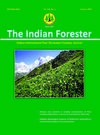Distribution of Dtpa-extractable Fe, Mn, Zn and Cu in Teak and Sandalwood-Supporting Soils in Seoni District, Madhya Pradesh
DOI:
https://doi.org/10.36808/if/2018/v144i1/121309Keywords:
Teak, Sandalwood, Pedon, Micronutrient Cations.Abstract
Two pedon from teak and two from sandalwood-supporting soils occurring on different landforms were studied for their morphology, DTPA-extractable micronutrient cations and some relevant physico-chemical soil properties in Seoni district, Madhya Pradesh. Teak-supporting Parasia pedon (plateau) was characterised by shallow, dark reddish brown soils with argillic clay horizon (Clayey Typic Haplustalf) whereas Mohgaon (undulating basaltic plateau) pedon had very deep solum, dark reddish brown, clayey soil with more than 50 per cent gravels (Clayey-skeletal Typic Rhodustalf). The sandalwood (natural)-supporting Salaia pedon (foot slope) was characterised by shallow, dark reddish brown to reddish brown soils classified as Clayey Typic Haplustept whereas other pedon (scarp slope) was shallow, very dark greyish brown, Clayey Typic Haplustept. The pH of the soils varied from 5.9 to 6.7 in teak-growing soils but it was 6.8 to 7.0 in sandalwood-growing soils. The organic carbon varied from 1.26 to 2.37 % in teak-growing soils which was higher than the sandalwood-growing soils and it ranged from 0.37 to 1.56 %. Cation exchange capacity ranged from 8.53 to 31.31 cmol(p+)kg-1 and 34.27 to 39.70 cmol(p+)kg-1 in teak and sandalwood-growing soils respectively. The soils had DTPA-Fe (1.68 to 36.04 mg kg-1),Mn (13.64 to 136.7 mg kg-1), Zn (0.60 to 2.60 mg kg-1) and Cu -1 (1.38 to 20.38 mg kg-1) in teak supporting soils. In sandalwood-supporting soils DTPA-Fe ranged from 6.68 to 14.94 mg kg-1, Mn (53.82 to 78.52 mg kg-1), Zn (0.48 to 1.40 mg kg-1)and Cu (7.60 to 10.98 mg kg-1). In general, pH showed negative correlation with micronutrient cations while, clay content and OC had positive correlation with DTPA-Fe, Mn, Zn and Cu. Surface layer of the soil had higher concentration of DTPA-extractable cations.References
Beemaiah G., Subramanyam M.V.R. and Ismail S.(1997). Performance of teak under different irrigation and fertilizer management practices. Indian Forester, 123(12) :1171-1175.
Behera S.K. and Shukla S.K. (2013). Depth-wise distribution of zinc, copper, manganese and iron in acid soils of India and their relationship with some soil properties. J. Indian Society of Soil Science, 61: 244-252
Behera S.K. and Singh D. (2010). Impact of continuous fertilizer use on fractions of manganese in soil and their contribution to availability and its uptake by maize (Zea mays)-wheat (Triticum aestivum) cropping system. Indian J. Agricultural Sciences, 80:316-320.
Behera S.K., Singh M.V., Singh K.N. and Todwal S. (2011). Distribution variability of total and extractable zinc in cultivated acid soils of India and their relationship with some selected soil properties. Geoderma, 162:242-250.
Black C.A. (1965). Methods of soil analysis. American Society of Agronomy, Madison Wisconsin, USA.
Goldberg S., Shouse P.J., Lesch S.M., Grieve C.M., Poss J.A., Forster H.S. and Suarez D.L. (2002). Soil boron extractions as indicators of boron content of field grown crops. Soil Science, 167(11): 720-728.
Harmsen K. and Vlek P. (1985). The chemistry of micro- nutrients in soil. Fertilizer Research, 7:1-42.
Hodgson J.F. (1963). Chemistry of micronutrient elements in soils. Advances in Agronomy, 15:15-19.
IFSR (2015). India State of Forest Report Forest Survey of India. Ministry of Environment and Forests, Dehradun.
Jackson M.L. (1973). Soil chemical analysis. Prentice Hall of India. Pvt. Ltd., New Delhi.
Jiang Y., Hao W., Zhang Y.G. and Liang W.J. (2006). Changes in soil nutrients with profile depth in aquic brown soil under different land uses. J. Soil and Water Conservation, 20:93-96.
Kumar P. and Sharma A. (2015). Available micronutrient status and their relationship with soil properties under different land uses in Kangra district of Himachal Pradesh. Agropedology, 25(1):140-146.
Lindsay N.L. and Norvell W.A. (1978). Development of DTPA soil test for zinc, iron, manganese and copper. Soil Science Society of America Journal, 42: 421-428.
Lindsay W.L. (1972). Zinc in soils and plant nutrition. Advances in Agronomy, 24: 147-186.
Luna R.K (1996). Plantation trees. International book distributors, Dehradun, India. 187-191pp.
Prasad A., Khatri P.K., Bhoumik A.K. and Totey N.G. (1990). Relation of teak mortality in Khandwa (M.P) and available soil iron and manganese. J. Indian Soc. Soil Sci., 38: 174-176
Prasad J. and Gaikwad S.T (1991). Site characteristics of soils supporting teak and sal of Mandla district, Madhya Pradesh. Van Vigyan, 29(3):180-181
Prasad J. and Gajbhiye K.S. (1999). Vertical distribution of micronutrient cations in some Vertisol profiles occurring in different eco-region. J. Indian Soc. Soil Sci., 47(1): 153-155.
Prasad J. and Patil R.B. (2002). Characterisation and classification of Teak (Tectona grandis) growing soils of Central India. Van Vigyan , 40(14): 35-48.
Richards L.A. (1954). Diagnosis and improvement of saline and alkali soils. USDA Agric. Handbook 60, U.S. Govt. Printing Office.
Singh K., Kuhad M.S and Dhankar S.S. (1989). Influence of soil characteristics on profile distribution of DTPA-extractable micronutrient cations. Indian J. Agri. Sci., 59:310-312.
Soil Survey Division Staff (2003). Keys to Soil Taxonomy, Ninth Edition. USDA, Natural Resources Conservation Service, Washington, D.C.
Walkley A. and Black I.A. (1934). An examination of Degtjareff method for determining soil organic matter, and a proposed modification of the chromic acid titration method. Soil Science, 37: 29-38.
Downloads
Downloads
Published
How to Cite
Issue
Section
License
Unless otherwise stated, copyright or similar rights in all materials presented on the site, including graphical images, are owned by Indian Forester.





